Ultrawide vs. Dual Monitors: Which is the Best Overall Setup

Debate over ultrawide vs dual monitors continues, but a winner is beginning to emerge. Ultrawide screens have both practical and aesthetic advantages over dual monitor setups and easily overcome challenges.
Continue reading for more details or click here for some recommended ultrawide monitors.
In the world of monitors, there are two kinds of people. Those who prefer ultrawide monitors and those who prefer to use a dual monitor set up.
Which one are you?
If you’re not sure, then let’s back up.
As I’m sure you’re all aware, extra horizontal screen real estate, whether by ultrawide or dual screen monitors, is always a plus! So much so, that for dual monitor users, going back to a single 16:9 monitor is often completely out of the question!
For people looking to extend their editing workspace, their first thought has traditionally been to get a second monitor screen and establish a dual monitor setup. Recently, however, ultrawide monitors (i.e. monitors with a 21:9 aspect ratio) are challenging the status quo and raising the question ‘when it comes to ultrawide vs. dual monitors, which is the best overall setup?’
The reason for this is because not only do ultrawide monitors provide extra screen real estate – but they keep it all on one single screen as well! With more ultrawide monitor options on the market than ever before, could ultrawide monitors be the way forward for productivity?
We decided to make the switch from dual monitors 16:9 monitors to a single ultrawide 21:9 monitor to find out for ourselves; ultrawide vs. dual monitors. Which is really the best overall setup? First, let’s take a look at the two scenarios and see what we’re getting into with an ultrawide monitor.
What Is a Dual Monitor Setup?
As the name implies, a dual monitor setup one in which you use two screens side by side to extend screen real estate, as opposed to just one. Traditionally, dual monitor setups would be composed of two monitors, each with a standard 16:9 aspect ratio and resolutions all the way up to 4K. In this type of dual monitor setup, each monitor’s resolution can either be the same or mixed, such as two 4k monitors, one 1080p, and one 1440p monitor – basic any combination you can imagine.
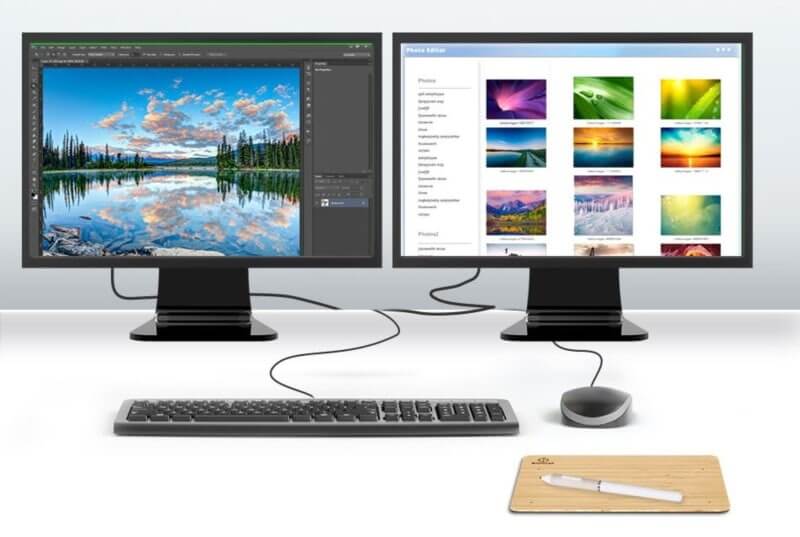
What Are Ultrawide Monitors?
To put it simply, ultrawide monitors are monitors that utilize a 21:9 aspect ratio rather than the traditional monitor screen ratio of 16:9. If you’re not familiar with a 21:9 aspect ratio, it is similar to the ratio of traditional movie theater screens.
If you’ve ever seen an ultrawide monitor then you already know how easily distinguishable they are from traditional monitors. Their widescreens are the most obvious indicator (as the name implies) and the result is an increase in horizontal screen space. In our comparison of ultrawide vs. dual monitors, we will be using the ViewSonic VP3881, which is a hefty 38-inch ultrawide monitor with a curved screen.
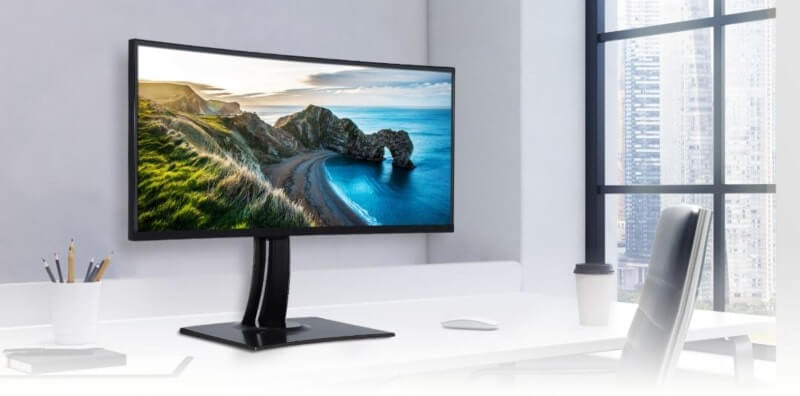
A quick look at this monitor’s specs can be found below:
- WQHD+ resolution (3840 x 1600)
- IPS panel
- Frameless bezel
- Delta E < 2 Color Accuracy
- Hardware color calibration
- HDR compatibility
- sRGB 99%
So now that we’ve found a suitable ultrawide monitor for editing on, how does the new setup stack up against the traditional dual monitor setup and which is the best overall setup?
Comparing Ultrawide vs. Dual Monitors
After switching to an ultrawide monitor and comparing ultrawide vs. dual monitor setups, here’s what we noticed:
Extended Screen Real Estate on One Screen
While dual monitors are one way of extending your screen space, one of the major downfalls has always been the gap between the two monitors, also known as the bezel gap. Even the thinnest bezels in the world can’t eliminate this problem!
The most noticeable improvement when switching to a single ultrawide monitor is finding that the dreaded bezel gap is no longer there to obscure your view. It’s a quality of life improvement that makes managing your workspace while doing things like editing or using multiple windows a whole lot smoother.
It’s difficult to go back to a setup with a bezel gap created by dual monitors after experiencing one seamless ultrawide screen setup.
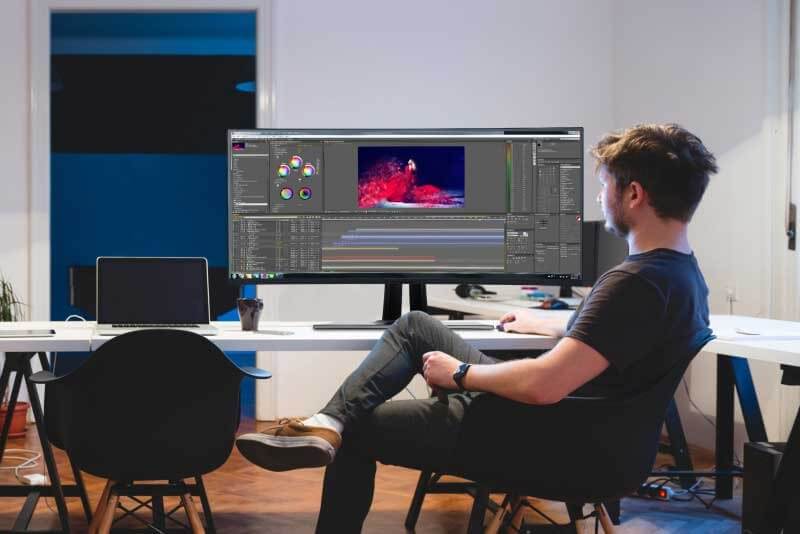
Cinematic Aspect Ratio
Aspect ratio is another noticeable feature when switching from a dual monitor setup to an ultrawide monitor, specifically in relation to watching movies. As we mentioned earlier, an ultrawide monitor leverages a 21:9 aspect ratio.
Since this aspect ratio is similar to what is used for making cinematic content, movies can be played at their native ratio. This eliminates letterboxing (i.e. the black bars on the top and bottom of the screen when watching a movie) and utilizes the entirety of the screen.
In fact, letterboxing only exists because when you watch movies on a monitor with a 16:9 aspect ratio, the only choice for making the content fit onto the screen is scaling the movie down in size. This allows the native 21:9 ratio image to fit within the confines of a 16:9 screen. Letterboxing is thus a byproduct of this process.
If you like to watch movies then watching them in full size, without letterboxing is a benefit you will realize immediately.
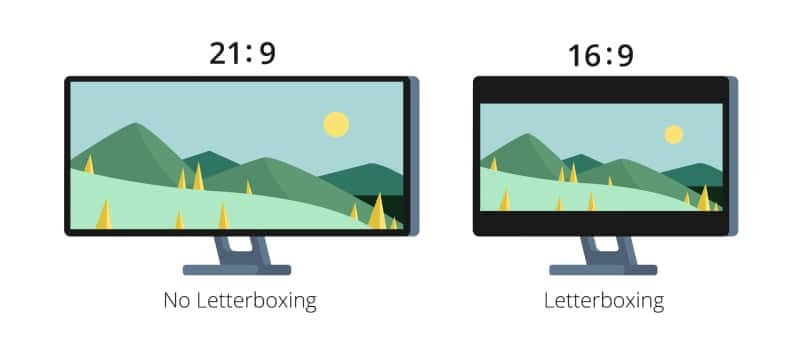
Consistency on One Screen vs. Two Screens
When it comes to consistency, there are numerous benefits of having a single, centralized screen over two independent screens. For starters, having one ultrawide screen eliminates fluctuations in color and uniformity that may arise when using dual monitors. If you’re a photographer or video editor these attributes are even more beneficial, as they directly relate to the quality of your work.
The issue with editing on dual monitors is that inconsistencies are bound to occur because of the fact that no two displays are created equal. This can become an issue when moving photos from one screen to another as you may not be sure which screen is displaying the most accurate information.
- Having a single ultrawide screen eliminates inconsistencies and delivers a smoother, more seamless experience than offered by dual monitors.
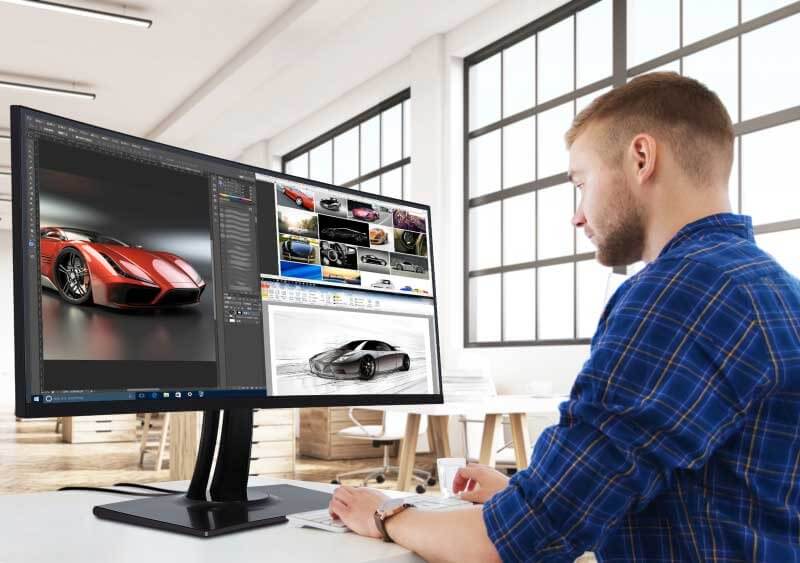
Window Management
For those comfortable with the ease of managing windows on dual monitors, the Windows Snap feature in Windows 10 implements similar window management functionality that is suitable for an ultrawide monitor. Using Windows Snap, you can easily snap windows to different areas of an ultrawide screen to have windows opened up side by side fairly seamlessly.
While both dual monitors and ultrawide monitors offer a slightly different take on window management, Windows Snap is an effective tool for managing multiple windows on an ultrawide monitor.
Convenience
In terms of convenience, there is no doubt that managing settings such as brightness and other display settings on a single monitor are simpler than doubling your work by making each adjustment twice. If you are planning to calibrate your monitor (as every professional editor should), there is no doubt that calibrating one single screen is much easier than calibrating two separate screens every time you need to calibrate.
Adjusting settings and calibrating one ultrawide monitor takes half the time and effort than it does to do the same for dual monitors.
Resolution and Screen Size
As you probably know, monitors come in a range of different resolutions. In a perfect world, a dual monitor setup would include two identical monitors – same size, same resolution; as we all know, however, this is not always the case.
While you can use dual monitors with different resolutions, it can be annoying when moving things from one screen to another, as you’ll have to adjust the size of whatever you’re dragging across. Dealing with two monitors of different sizes has its own shortcomings as well.
Note: WQHD seems to be a sweet spot for using both photo editing and video editing software. Using an ultrawide with a higher resolution really brings out the benefits of having horizontally extended screen space.
One solution for this is to just match the resolutions of the two screens via the monitor settings.
The downside of this, however, is that you would have to match both monitors’ resolutions to that of the lower resolution screen, forcing you to downgrade your higher resolution screen. In this setting, a single ultrawide monitor has a clear advantage as it is one uniform resolution all the way across.
In the case of the monitor that we used in this ultra wide vs. dual monitor comparison, it comes equipped with a high WQHD+ (3840 x 1600) resolution (the ‘+’ refers to the screen’s horizontally extended screen space). Having an ultrawide monitor with a higher resolution seems to help maximize the extra horizontal real estate in a way that pairs very nicely with an ultrawide screen.
Ultrawide monitors are a convenient solution for ensuring that resolution and screen size stay consistent across your entire display.
Added Benefit: Curved Immersion
With a dual monitor setup you can set them up side by side or set them up at an angle but you can never make them curved. The monitor we used leverages a curved screen, which helps to create a feeling of immersion that is not attainable on a dual monitor setup.
- The panoramic nature of an ultrawide screen paired with a curved panel feels as if it keeps your peripheral vision engaged in a comfortable way that feels more natural than when looking at dual monitors.
Ultrawide vs. Dual Monitors: The Verdict
We already know both ultrawide and dual monitor setups are an excellent way to boost your editing productivity. When comparing an ultrawide vs. dual monitor setup though, there is some significant quality of life changes that come along with an ultrawide monitor that is unmatchable by dual monitors.
Whether you’re someone who has become accustomed to using a dual monitor setup or are currently using a single 16:9 monitor, switching to an ultrawide monitor is definitely worth some consideration. When it comes to comparing ultrawide vs. dual monitors, ultrawide monitors definitely have some significant advantages over dual monitor setups that are hard to ignore.
Luckily for all of us, ultrawide monitor options (including ultrawide curved monitors) are becoming more and more common. Moreover, it’s not hard to find ultrawide monitors for specific usages nowadays either, such as ultrawide gaming monitors.
If you are interested in exploring some ultrawide monitor options for photography and editing, the ViewSonic ultrawide monitor referenced in this article is a solid option as well, as it is designed for excellent color performance and accuracy. Or learn more about ViewSonic’s range of monitors here.
Source:https://www.viewsonic.com/library/photography/ultrawide-vs-dual-monitors/ Date: 04.08.2021г.



